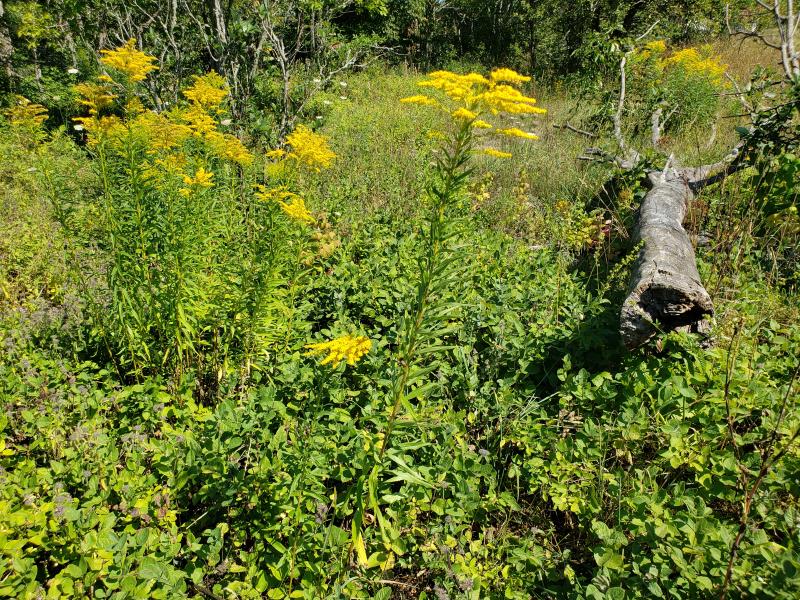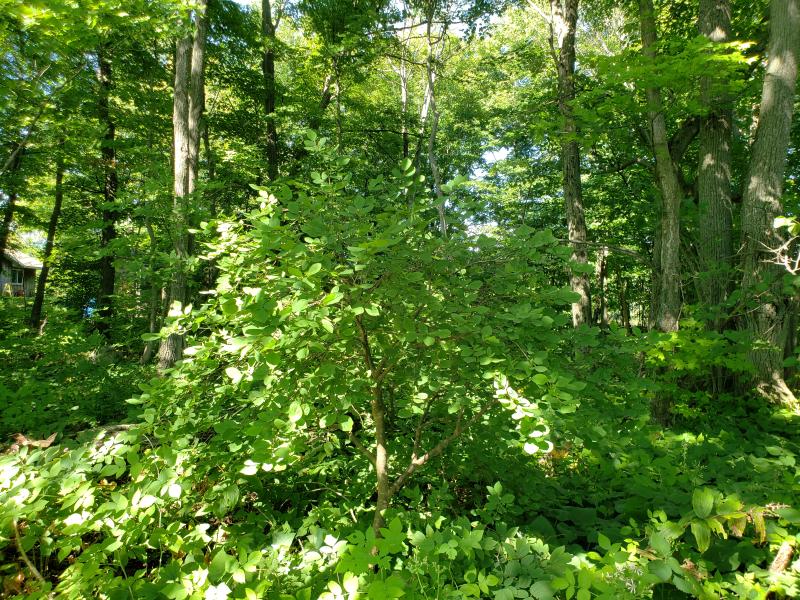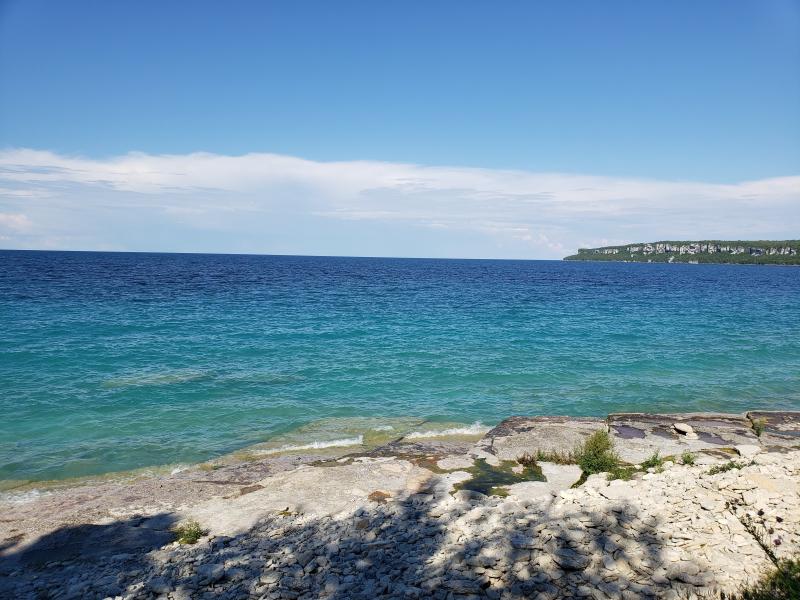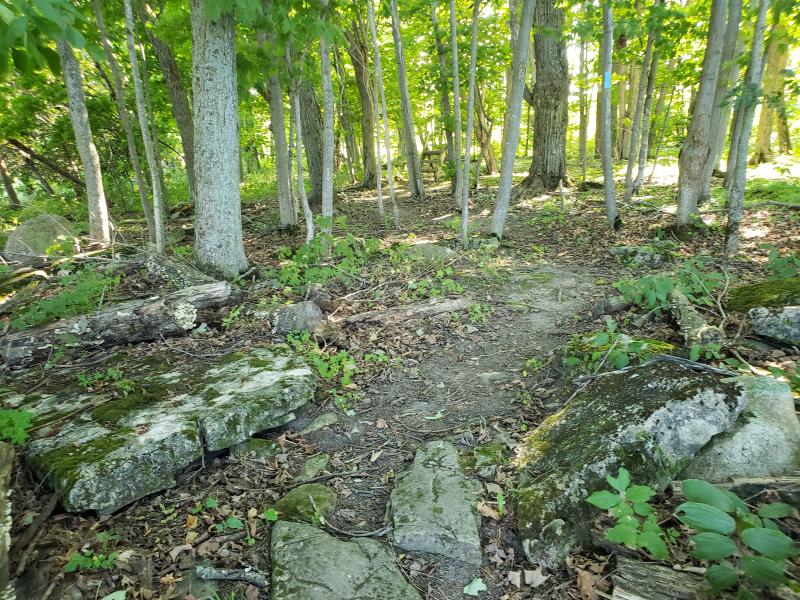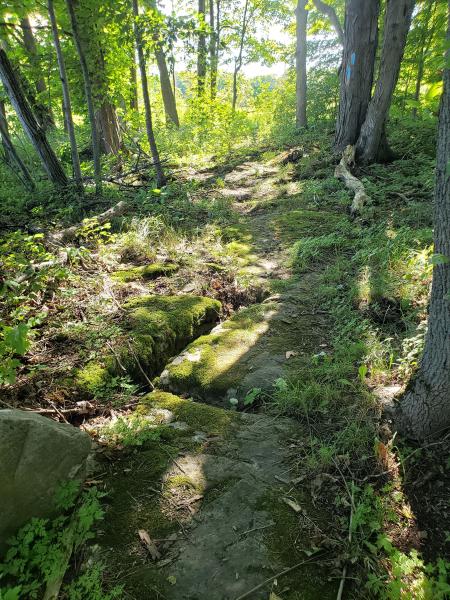
Maplecross Nature Reserve
Kanyataraktátye’ “Along the Lake”
Neyaashi Daamkan/ Ninaatig Jiibyaatig Wendaajwanong Shkonaan
Location
GPS Coordinates
The Maplecross Nature Reserve at Cape Chin is a 211.65 ha property that was purchased by the Bruce Trail Conservancy in 2021, and is currently managed for conservation. The property sits on the coastline of Georgian Bay on the eastern edge of northern Bruce peninsula. Located on the Peninsula section of the Niagara Escarpment, the nature reserve is accessible via the Bruce trail, which winds through abandoned and regenerating pastureland, deciduous forests, and cliffside mixed forests. There is also a lookout point that provides a panoramic view of the cliffs and waters of Georgian Bay. Maplecross is furthermore habitat for at-risk species of birds, bats, and flora, including the Massasauga rattlesnake, and Sandhill cranes, both of which the researchers saw when visiting this site during the survey.
The Bruce trail begins at a bend in Cape Chin North Road, at the north end of the nature reserve, and travels in a south easterly direction towards the cliffs of the Niagara Escarpment that overlook Georgian Bay, before winding back southwest to form a half-loop. The first stretch of the trail goes through abandoned pastureland, characterized by open meadows of tall grasses and sun-loving plants, including asters, goldenrods, yarrow, and hawkweeds, as well as exotic plants associated with agriculture, such as mullein and chicory. As the trail approaches the cliff face, the abandoned fields transition to regenerating mixed-wood forests, which are represented by a mix of native species, and exotic species associated with agriculture. Trees include balsam fir, sugar maple, trembling aspen, and green ash, as well as apples and hawthorns, which are associated with former agricultural land use. Common shrubs in the understory include chokecherry, round-leaved dogwood, and northern bush honeysuckle. Ground vegetation is diverse, and include sarsaparilla, Canada mayflower, barren strawberry, Canadian lousewort, rattlesnake plantain orchid, blue cohosh, and cow-wheat, as well as pasture species such as speedwell, birds-foot-trefoil, hawkweed, and fleabanes. As the trail reaches the cliff edge, ancient cedars become the dominant species.
The southern half of Maplecross is home to mature coniferous and mixed-wood forests. Coniferous elements include balsam fir, white spruce, and cedar, and deciduous components include trembling aspen, red maple, paper birch, and green ash. Common ground-level species include sarsaparilla, Canada mayflower, gaywings, twinflower, bracken fern, Labrador violet, prickly wild rose, bunchberry and helleborine orchid. Forests on drier soils, which often occur over bedrock close to the surface, are also home to northern bush honeysuckle, common juniper, round-leaved dogwood, mountain ash, and limber honeysuckle in the shrub layers, and bearberry, spleenwort, fleabanes, hawkweeds, and large-leaved asters in their ground-layer.
Forests on moist soils, such as near lake margins, also have sedges in the ground layer. Some rare species found in these forests include Ontario’s native orchids, such as yellow lady’s slipper, showy lady’s slipper, rattlesnake plantains, and coralroots. The margins of the two lakes in the south end of the property support rich wetlands, including moist meadows with an abundance of painted cup/Indian paintbrush. Finally, the very southwest tip of the property is home to rich maple, beech, and ironwood deciduous forest.
Archaeologists characterize human livelihoods in the northern Saugeen (Bruce) Peninsula as beginning during the Paleoindian period, which is a period of time that followed the end of the last ice age (12,000 – 10,000 BC). Importantly, the conversation about Indigenous prehistory is changing, notably with the publication of Paulette Steeves’ “Indigenous Paleolithic in the Western Hemisphere,” which re-interrogates archaeological evidence to show that Indigenous peoples lived in North America for far longer than the Bering Strait theory postulates, placing the Paleolithic further into prehistory, between 100,000 and 60,000 years ago. Archaeological findings from 12,000 – 10,000 years ago consist of small rotational campsites (likely seasonal settlements), usually located within 2 km of pre-historic shorelines, represented by stone materials. These findings may suggest a reliance on aquatic resources for food. Furthermore, post-glacial low lake water levels surrounding Saugeen (Bruce) Peninsula persisted up to 7000 years ago, and it is possible that human activity also took place in areas that are now submerged in water. Currently, only one cultural artifact has been recovered from underwater archaeological research; this artifact is a fire cracked rock excavated from an ancient shoreline off the northern tip of the Peninsula, that is now 30 m underwater.
Ancient peoples followed mobile lifeways that were based upon harvesting wild and managed plant foods, hunting, and fishing through the Archaic and Woodland periods. Sites from these periods continue to remain close to lakeshores, except for small inland camps that were thought to have been occupied by small groups of families during the hunting seasons of the fall and winter. Different patterns of material culture emerge at these camps over time.
During the Late Archaic (1000 BCE to 700 CE), burial practices with ceremonial elements begin to appear, such as the sprinkling of hematite (red ochre) powder around the bodies of the dead and grave offerings, which include polished stones, copper rings, brass bracelets and other special materials. The presence in graves of copper from Lake Superior, silver from current day Timiskaming, galena (a lead ore) from the St. Lawrence valley, and Onondaga chert from Lake Erie provides evidence of long-distance trade among Indigenous peoples. Also during this time, Pukaskwa pits, which are circular depressions dug into the ground and covered with dolostone or limestone slabs, appear for the first time. Their purpose is not known, but archaeologists speculate that they could have been used for burials, storage, or hunting blinds. Finally, the earliest remains of fishing weirs, which are structures set up at stream-mouths to intercept fish, date to the Late Archaic. Several ancient fishing weirs have existed on the eastern side of the peninsula, including at Lion’s head.
Historical ceramics begin to appear in the archaeology of the Saugeen (Bruce) peninsula during the Woodland periods. One of the most well-documented archaeological sites in the northern peninsula, the Hunter’s Point site, was found with Iroquoian-style ceramics, as well as older pottery styles that exhibit cord wrap designs. The Hunter’s Point site, located on a pebble beach near present day Cape Croker, was inhabited at various points in history, including from 200 BCE to 800 CE and 1200-1600 CE, but the period of heaviest occupation was during the Late Woodland (1200 – 1650). Several rectangular structures from this site may have been associated with ceremonial activities. This has been inferred due to the presence of copper effigies and bear skeletal remains painted with red ochre within these structures, and the cardinal orientation of the structures themselves. Furthermore, in Ojibwe oral history, the eastern shore of northern Saugeen (Bruce) peninsula, and especially the Hope Bay area, was and is spiritually important as a place for healing.
During the 1500-1600s, the Odawa lived and were active in trade in and around the Saugeen (Bruce) Peninsula and Manitoulin Island, in tobacco, furs/ skins, sunflower oil, cornmeal, and medicinal roots and herbs. During the 17th Century, during the Beaver Trade, they maintained strong economic and military ties with the Tionontati (Petun or Tobacco people) when conflict arose during times of war against the Haudenosaunee Confederacy. When the Saugeen (Bruce) Peninsula was depopulated following Haudenosaunee attacks during the Beaver Wars, the Saugeen Ojibway Nation repopulated the region following the end of the war. These new Ojibwe settlements also sheltered the survivors of the Tionontati (Petun or Tobacco) and Attiwandaron (Neutral) Nations who were not taken into Haudenosaunee society. During the 1700s, Ojibwe Nations continued to live on the Saugeen (Bruce) Peninsula, where they hunted for food sources and trade as part of their livelihoods.
In 1836, the Saugeen Ojibway Nation signed Treaty 45 ½ with the Crown, a treaty which was supposed to allow 600,000 hectares of land around Owen Sound to be designated as Crown land, in return for provision of economic support, housing, agricultural resources, and a commitment that Europeans would never settle in Bruce Peninsula and the Manitoulin Island. However, the Crown did not honor that commitment by stopping settlers from migrating north to the Bruce Peninsula area. In 1854, Treaty 72 was signed between the Ojibwe and the crown, which re-negotiated the previous land agreement by establishing the boundaries of specific reserves for the Saugeen Ojibway and Chippewas of Nawash First Nations, in exchange for allowance of European settlement of the Bruce Peninsula. Furthermore, the signatory First Nations were to receive all proceeds from the selling of the land, to be held in trust. During the treaty signing period, European settlers arrived and participated in logging and fisheries in Georgian Bay, which became the predominant industries until the beginning of the 1900s. In the years following World War II, deforestation and the introduction of invasive lamprey eels devastated these resource economies. Currently, Bruce Peninsula is best known for its tourism industry.
In 1994, the Saugeen Ojibway Nation (SON), comprised of the Saugeen First Nation and Chippewas of Nawash Unceded First Nation, began land claims litigations within the Bruce Peninsula. The SON was finally able to assert their claim that the Crown could have done more to prevent settlement of the Bruce Peninsula per the terms of Treaty 45 ½, but chose not to do so. This was a breach of the commitment on the part of the Crown, and they believe that the Crown also misled SON into signing Treaty 72. The SON litigation pursues three claims: 1. Aboriginal title over the water territory of Lake Huron and Georgian Bay, which was not surrendered through treaty, 2. Aboriginal title to all Crown Land and some public lands in the Bruce Peninsula, including municipal and shore road allowances, and 3. $90 billion in compensation for lost hunting rights and private lands that cannot be returned. The land claim went to trial in April 2019. Thus far, several out-of-court settlements have taken place, including the return to Saugeen Ojibway Nation of 306 acres of County Forest in Bruce County, and 275 acres of county forest in Georgian Bluffs, Grey County.
A Brief History of the Saugeen Peninsula (2018) by David D. Plain.
Bruce Trail Conservancy secures 533-acre ‘gem’ on Bruce Peninsula: Bruce Trail Conservancy secures 533-acre 'gem' on Bruce Peninsula | Owen Sound Sun Times
Farmers, Fishers, Hunters and Trades – Indigenous Communities on Georgian Bay, by ASI: https://asiheritage.ca/publication/farmers-fishers-hunters-and-trades-indigenous-communities-on-georgian-bay/
Georgian Bay Biosphere Species at Risk Group: https://georgianbaybiosphere.com/species-at-risk/
Georgian Bay Biosphere “State of the Bay, Gnawenjigaadeng Mnidoo-gamii Protecting the Great Lake of the Spirit.” 2023.
The illustrated history of the Chippewas of Nawash (2003) by Polly Keeshig-Tobias
The Northern Bruce Peninsula Ecosystem: chapter2.indd (wildlandsleague.org)
Saugeen Ojibway Nation website: https://www.saugeenojibwaynation.ca
The Saugeen Land Claim and the ‘Path of Peace’: https://owensoundhub.org/opinion/12571-the-saugeen-land-claim-and-the-path-of-peace.html
Saugeen Ojibway Nation land & Aboriginal Title Claim Set to Begin:
Saugeen Ojibway Nation Land & Aboriginal Title Claim Trial Set to Begin | Bruce Peninsula Press
Under Siege: How the People of the Chippewas of Nawash Unceded First Nation Asserted Their Rights and Claims and Dealt with the Backlash (2005) - Chippewas of Nawash Unceded First Nation Report to the Ipperwash Inquiry, Pages 1-13.
Welcome to the Saugeen Ojibway Nation: https://www.youtube.com/watch?v=dv_jGZyg0Lc
| English | Latin | Kanienʼkéha | Anishinaabemowin |
|---|---|---|---|
| Green Ash | Fraxinus pennsylvanica | kaneróhon | emikwaansaak, aagimaak, bwoyaak |
| Balsam Fir | Abies balsamea | otshohkó:ton | zhingop |
| Red Maple | Acer rubrum | ka’takén:ra | zhiigmewanzh, zhiishiigimiiwanzh (-iik, plural) |
| Sugar Maple | Acer saccharum | wáhta’, ohwáhta | ininaatik, ininaatig (-oog, plural) |
| Spreading Dogbane | Apocynum androsaemifolium | wahseriye'tonnyà:tha, skatsí:wa'k | sasa'bikwan, ma'kwona'gicobji'bik |
| Wild Sarsaparilla | Aralia nudicaulis | tsyotere'se'kó:wa, yonekó:wa, tsyawenséhsha, otsyawénhsa | waaboos-odji-bik, waabooz jiibik |
| Bearberry | Arctostaphylos uva-ursi | onerahtontahkó:wa | zaagaakominagaawanzh/iig “emerges like a stick - berry plant/s” |
| Blue Cohosh | Caulophyllum thalictroides | karhakón:ha, kahrhatakon | kwemshkiki, be'cigodji'bigak, bezhigojiibik, zhiigimewibag |
| Pipsissewa | Chimaphila umbellata | gaagigebagohns, gaabgebak | |
| Bunchberry | Cornus canadensis | (check this) | caca’gomin, zhaashaagomin |
| Round-leaf Dogwood | Cornus rugosa | (check this) | mazh’omizh |
| Québec Hawthorn | Crataegus submollis | ohì:kta wahyarà:ken, yotironhwentsí:yo | miinensgaawanzh |
| Wild Carrot | Daucus carota | anonhsanónhna, watatewenní:yo otsíhkwa | kaadaakoon |
| Broad-leaved Helleborine | Epipactis helleborine | (check this) | (check this) |
| Large-leaved Aster | Eurybia macrophylla | teyonerahtawe'éhston, orón:ya yotiron’onhkóhare, iotsiron'onhkóhare oròn:ia, yako’tonhkwárhos onónhkwa, iako'tonhkwáhrhos onónhkwa | migiziwibag |
| Wild Strawberry | Fragaria virginiana Duchesne | ken’niiohontesha, niyohentéhsha’, niyohontéhsa, ken’niyohontésha | odeimin (-an, plural) |
| Green Ash | Fraxinus pennsylvanica | kaneróhon | emikwaansaak, aagimaak, bwoyaak |
| Appalachian Barren-strawberry | Geum fragarioides | (check this) | (check this) |
| Rattlesnake Plantain | Goodyera pubescens | (check this) | gne’bigwak, medwewenhak |
| Twinflower | Linnaea borealis | (check this) | niizhhodeyan |
| False Solomon’s Seal | Maianthemum racemosum | kítkit o'éta | agongseminan, agongosimizh, agong’osiminan |
| Apple | Malus spp. | sewahyó:waneh “one big fruit” | mishiiminaatik, mishiiminaatig |
| Wood Betony | Pedicularis canadensis | (check this) | naadweaanak, mandaamini- ojiibikens |
| Fringed Polygala | Polygala paucifolia | (check this) | tikizidgiibikohnse |
| Trembling Aspen | Populus tremuloides | onerahtón:ta, o’nerahtón:ta, orahaton takorokwa | azaadi, azaadiins, azaadiins, azaadiig, zaad, zaat |
| Heal-all | Prunella vulgaris | yako'nikonrákhas onónhkwa, katsitsoró:kon | ingijibinaa, ogijibinaan, basi’bagak |
| Black Cherry | Prunus serotina | é:ri, e:ri’kó:wa, tyotyò:ren | ookweminagaawanzh, ookweminan, ikwe'mic |
| Chokecherry | Prunus virginiana | tyakonya’tawén:’eks, teyakonya’tawén:’eks | asasaweminagaawanzh, asasaweminan, baakinminaan, asasaweminogaawangh |
| Bracken Fern | Pteridium aquilinum | yetskaronhkwa'kó:wa | zhishkwedaansan, naanaaganashk (-oon), mzise miijim |
| Gooseberry and currant species | Ribes spp. | tyorenatsí:yo, ohrá:ton, anáduma:o:náhi, nikanenharà:sa | zhaabo-miinashkoon, zhaaboomin (-aak, plural), me’skwacabo’minak, kaawe-saba, mieidji’minaga’wanjiig, waaboos-odji-bik , gaagaagshiinh miinan |
| Prickly Wild Rose | Rosa acicularis | yako’tanentáktha, teyohnyonwarón:ton | oginiiwaatik, gaawaak-bagoohnseak |
| Dwarf Raspberry | Rubus pubescens | skanekwen’terá:yen, skanekwen’terá:ne, skanekwenhtará:nenh | miskomin (-ak, plural) |
| Purplestem Aster | Symphyotrichum puniceum | teyonerahtawe'éhston, yotsiron’onhkóhare orón:ya | wiiniziikens |
| Canada Goldenrod | Solidago canadensis | otsí:nekwar niyotsi’tsyò:ten | ajidamoowaanow, waabanoominens/waabanoominensag, giizisso mashkiaki |
| Dandelion | Taraxacum officinale | tekaronhyaká:nere | mindemoyanag, doodooshaaboojiibik, mindimooyenh, wezaawaaskwaneg |
| White Cedar | Thuja occidentalis | onen’takwehtèn:tshera | giizhigaa'aandak, giizhik |
| American Elm | Ulmus Americana | akará:tsi'kowa | aniib, niip |
| Labrador Violet | Viola labradorica | tekonnyarotárhoks, tekonteniarotáhrhoks, tewatenyarotárhos | we-waawiyeyaa-bagak, wewaie’bagag |


